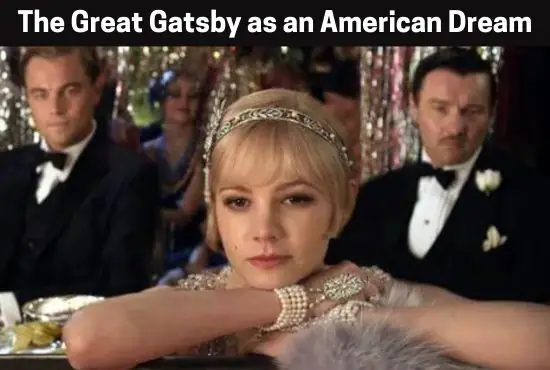The Great Gatsby as an American Dream
“The Great Gatsby” by F. Scott Fitzgerald is often regarded as a quintessential exploration of the American Dream. Published in 1925, the novel offers a critique of the Jazz Age society and delves into the themes of wealth, social status, and the pursuit of happiness. The novel follows the life of Jay Gatsby, a young man pursuing the American dream. The American dream, also known as the ethos of the United States, is a set of ideals in which life should be richer, better, and more fulfilling for every individual.
“The Great Gatsby” portrays the American Dream as an illusion, a mirage that seems attainable but is ultimately unattainable for most. Jay Gatsby, the novel’s enigmatic protagonist, epitomizes the American Dream’s facade. Born into poverty, Gatsby reinvents himself as a wealthy man to win the love of Daisy Buchanan, a woman from a wealthy background. Despite accumulating vast wealth, Gatsby’s pursuit of Daisy proves elusive, emphasizing the ephemeral nature of the American Dream. Gatsby is a self-made man who amasses a fortune through bootlegging during the Prohibition era. He believes that wealth and material possessions will enable him to win back his lost love, Daisy Buchanan, and ultimately attain happiness.
Gatsby’s extravagant parties, filled with revelry and excess, serve as a symbol of the empty pursuit of happiness associated with the American Dream. The guests, driven by materialistic desires, use Gatsby’s parties to escape their own realities. However, beneath the glitz and glamour, the hollowness of their lives becomes apparent, highlighting the emptiness of the American Dream’s pursuit. His extravagant parties, lavish lifestyle, and opulent mansion in West Egg are symbols of his material success, but they cannot fill the void in his life or bridge the gap between him and the old money world of East Egg.
Also Read:
Fitzgerald also highlights the corruption and moral decay that accompany the relentless pursuit of wealth and social status. The characters in the novel, particularly the wealthy elites of East Egg, are portrayed as shallow, materialistic, and morally bankrupt. They are consumed by their own self-interests, indifferent to the consequences of their actions on others. The rampant hedonism and excess of the Jazz Age society further underscore the emptiness and hollowness of the American Dream.
The Great Gatsby also reveals the flaws in the American dream. The novel portrays characters who are chasing their dreams without considering their personal responsibilities and relationships. Daisy Buchanan, for instance, is depicted as a character who is obsessed with wealth and status without regard to personal integrity. She is, therefore, a representation of the more negative aspects of the American dream.
Tom Buchanan, a symbol of inherited wealth, embodies the arrogance and sense of entitlement associated with the upper class. His affair with Myrtle Wilson, a lower-class woman, illustrates how social boundaries are reinforced and how the American Dream remains an elusive fantasy for those outside the privileged circles.
Furthermore, through the character of Nick Carraway, Fitzgerald portrays the American dream as contradictory and conflicted. Nick is introduced as an outsider who aspires to live the sophisticated life as Gatsby does. However, his values and ethical principles conflict with the hedonistic lifestyle that he encounters in Gatsby’s inner circle. The novel portrays the American dream as full of contradictions and conflicts, suggesting that it is not an easy pursuit.
In conclusion, “The Great Gatsby” presents a complex and nuanced portrayal of the American Dream. While it initially appears as a beacon of hope and opportunity, the novel exposes its flaws and the inherent contradictions within a society driven by materialism and social stratification. By exploring the themes of wealth, social status, and the pursuit of happiness, Fitzgerald invites readers to question the true nature and viability of the American Dream, ultimately painting a picture of its elusive and ultimately unfulfilling nature.

Hello, Viewers! Besides being the Founder and Owner of this website, I am a Government Officer. As a hardcore literary lover, I am pursuing my dream by writing notes and articles related to Literature. Drop me a line anytime, whether it’s about any queries or demands or just to share your well-being. I’d love to hear from you. Thanks for stopping by!
